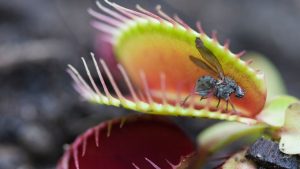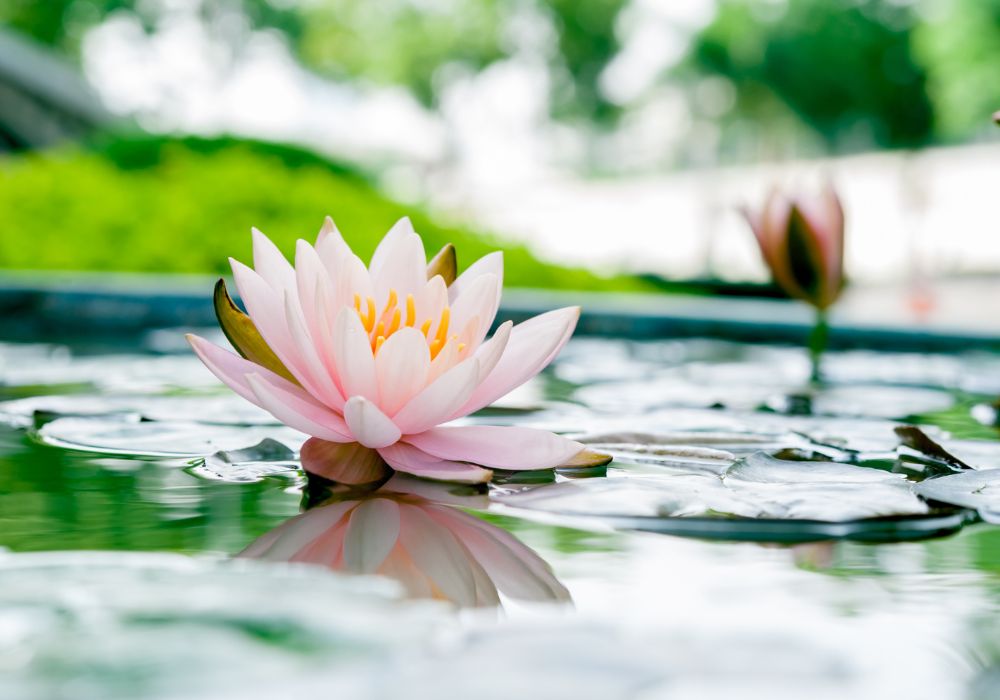
Building a peaceful water garden will turn your outside area into a haven. Including a lovely aquatic plant like the lotus flower will help you to reach this most effectively. Renowned for its delicate petals and arresting look, it gives any water feature beauty and peace. Growing this plant calls for attention and care, but with the correct technique the process is under control.
From selecting the correct surroundings to preserving good development, this guide will walk you through the required actions to properly nurture it. You will shortly have a calm garden to enjoy all year long.
Understanding the Lotus Flower
Contents
Renowned for its big, vivid blossoms rising above the water on long, elegant stems, the lotus is an arresting aquatic plant. Its rounded leaves float on the water’s surface, strikingly contrasting the vibrantly colored flowers, which run white to tones of pink and yellow. Any water garden gains dynamic elements from these blossoms opening during the day and closing at night. Across many civilizations, the plant has come to represent beauty, resiliency, and spiritual development because of its unusual ability to flourish in muddy waters yet bloom with such purity.
In Eastern traditions, this bloom has great religious and cultural value. In Buddhism and Hinduism, it represents purity, enlightenment, and rebirth, that which emerges clear and brilliant from muddy seas. Often connected with gods and revered in art and architecture, the plant Apart from its symbolic and aesthetic worth, the lotus is also useful since its seeds, leaves, and roots find use in many different cooking and medicinal projects.

Choosing the Right Location for Your Lotus
Selecting the proper location is one of the most crucial steps when growing lotus flowers. Lotuses are aquatic plants that require specific conditions to thrive. With the right environment, you’ll ensure healthy growth and vibrant blooms that add elegance to your water garden. In this section, we’ll explore the ideal conditions for your plants to flourish.
Importance of Sunlight
Lotus plants need full sunlight to bloom and grow properly. At least six hours of direct sunlight per day is essential for their health. If your water garden is located in a shaded area, you may notice fewer flowers or slower growth. Choose a sunny spot in your garden where the plants will receive plenty of warmth throughout the day. This helps the plants produce large, colorful blooms and ensures the water stays warm enough for optimal growth.
Without sufficient sunlight, the leaves may become smaller, and the flowers won’t reach their full potential. If you’re planting in a container, make sure you can move it around to maximize sunlight exposure. This flexibility can be beneficial, especially in changing seasons when sunlight may shift. Just remember, the more sunlight your plant receives, the more vibrant and healthy it will be.
Water Depth and Temperature
Another important factor in choosing the right location is water depth. Lotus plants grow best in water that’s between 12 and 18 inches deep. Shallow water warms up faster in the sun, which benefits these tropical plants. Keeping the water warm for as long as possible is essential in cooler climates. However, avoid water that’s too shallow, as the roots need enough space to spread and anchor themselves.
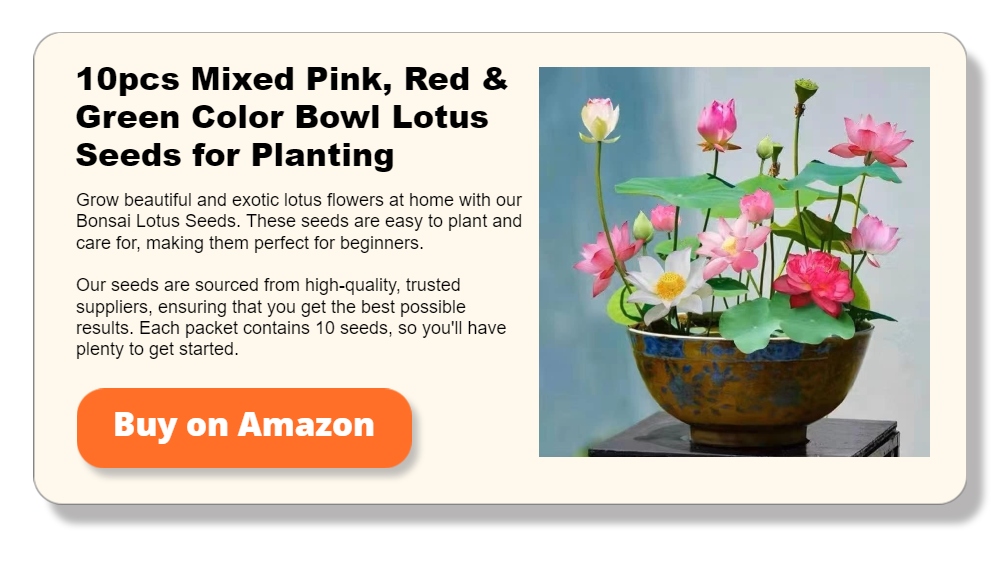
Temperature also plays a key role in the growth of these plants. The water temperature should ideally stay above 75°F (24°C) during the growing season. If you live in a cooler region, consider placing your water garden in a location that naturally retains heat, such as near a wall that absorbs and reflects sunlight. This can create a microclimate that encourages better growth, even in less-than-ideal conditions.
Container-Grown Lotus
Growing lotus flowers in containers is an excellent option for those without large ponds. Containers offer more control over water depth and temperature, especially in regions with fluctuating climates. When selecting a container, choose one at least 18 inches wide and 10 inches deep. This size gives the roots ample room to grow while maintaining the right amount of water.
Containers also allow you to move your lotus plants to different parts of your garden throughout the season. If one spot isn’t getting enough sunlight or warmth, you can simply shift the container to a sunnier location. However, be mindful of keeping the water clean and free of debris. Containers can accumulate algae or fallen leaves, which can affect water quality. Regular maintenance is essential to ensure a healthy growing environment.
The proper site for your lotus plants is crucial for creating a beautiful and tranquil water garden. Ensuring they get lots of sunlight, the right water depth, and protection from strong elements will promote good development and amazing blossoms. Considering their surroundings will pay off with a calm and lovely garden centerpiece, whether you plant them in a pond or container.

Preparing the Planting Area
Before planting lotus flowers, preparing the area properly is essential to give them the best possible start. The success of your lotus plants largely depends on the right combination of soil, water conditions, and planting techniques. This section will discuss how to create an ideal environment for lotus flowers to thrive.
Soil Requirements for Lotus Flowers
Lotus flowers grow best in heavy, clay-based soil that retains nutrients well. This type of soil provides stability for the roots, preventing them from floating or being displaced. Avoid using regular potting or garden soil, as they float and cloud the water. A mix of clay and aquatic planting media will offer the best conditions for your lotus flowers.
If you’re planting lotus flowers in a container, fill it with 4-6 inches of this soil mixture. You can create a shallow clay bed at the bottom for pond planting. The roots need something substantial to anchor into, and heavy soil will provide that support while also delivering essential nutrients to your lotus flowers.

Creating the Ideal Water Environment
Water depth and quality are crucial factors in preparing the planting area for lotus flowers. Lotus plants thrive in shallow water, about 12-18 inches deep. If the water is too deep, it can prevent young shoots from reaching the surface. If it’s too shallow, the roots may dry out, or the water may become too warm, stressing the plants.
Whether you’re planting in a pond or container, ensure that the water is clean and free of harmful chemicals. Lotus flowers prefer still or slow-moving water, so avoid planting them in areas with strong currents. If you’re using tap water, allow it to sit for 24 hours to let any chlorine dissipate before introducing it to your lotus flowers.
By carefully preparing the planting area, you’ll set the foundation for healthy lotus flowers that will flourish in your water garden. A well-prepared environment encourages faster growth, vibrant blooms, and long-lasting plants, adding peace and beauty to your space.
Planting Techniques for Lotus Flowers
Planting lotus flowers requires careful attention to detail to ensure they grow healthy and strong. Whether you’re working with seeds or tubers, the right techniques will help your lotus flower flourish. This section focuses solely on the planting process to give you a clear understanding of how to get started.

Planting Lotus Seeds
If you’re starting from seeds, the first step is to scarify them. Lotus seeds have a hard outer shell, and gently filing or sanding down one end helps water penetrate, encouraging germination. Place the scarified seeds in a container of warm water, changing the water daily. After a few days, you’ll notice the seeds begin to sprout. When the sprouts reach about 2-3 inches long, they can be transferred to a more permanent home.
For planting in a pond or container, carefully place the sprouted seeds in 4-6 inches of aquatic soil. Make sure to bury them lightly, leaving the sprouts exposed. Water the soil gently to settle it, being careful not to disturb the delicate roots. Lotus flowers started from seeds may take longer to bloom, but with patience, they’ll soon add beauty to your garden.
Planting Lotus Tubers
Lotus tubers are a popular choice because they tend to grow faster than seeds. When planting a lotus tuber, handle it carefully to avoid damaging the growing tip. Dig a shallow hole about 4 inches deep in the soil of your container or pond. Place the tuber horizontally in the hole, ensuring that the growing tip is pointing upwards and the roots are spread out.
Cover the tuber lightly with soil, but don’t bury it too deep. The tip should remain slightly exposed so it can grow toward the surface. Once the tuber is in place, slowly fill the container or pond with water to ensure the tuber stays in position. The lotus flower will begin to sprout with proper care within a few weeks.
Water Depth for Planting
Lotus flowers thrive in shallow water. When planting them, ensure the water depth is between 12-18 inches. This allows the plant’s shoots to reach the surface easily while providing enough space for the roots to anchor. If you’re planting in a pond, check the water level regularly, especially during hot weather, to ensure it remains within the ideal range.
For container planting, you can start with less water, gradually increasing the depth as the plant grows. Keep an eye on the leaves as they begin to appear above the water’s surface. Once the lotus flowers are well-established, you can maintain a consistent water depth to support their growth.
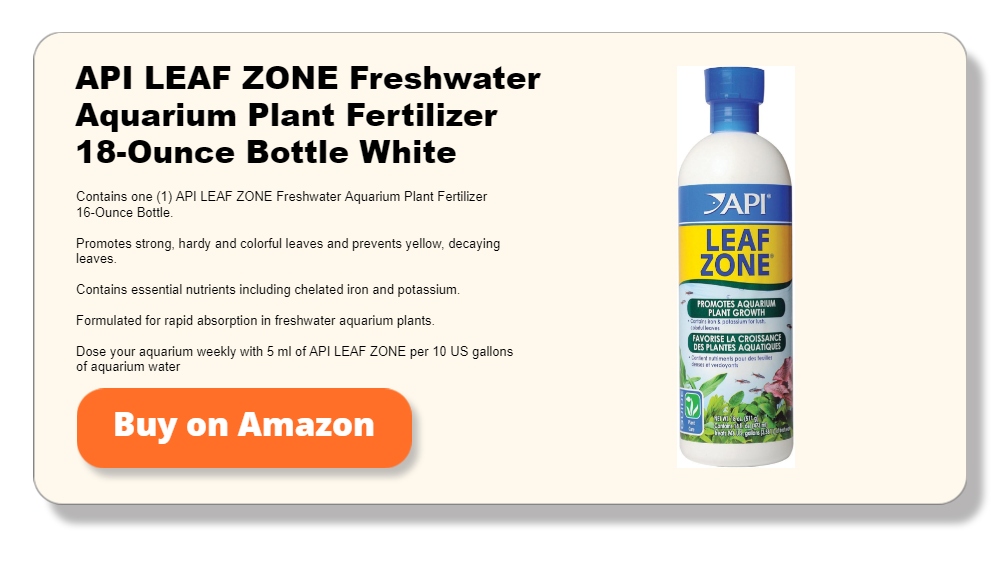
Proper Spacing for Lotus Flowers
Lotus flowers need room to grow, so giving them adequate space is important. When planting in a pond, space the tubers about 3-4 feet apart to allow the leaves and flowers to spread. If you’re using a container, ensure it’s large enough, or about 18 inches wide, to accommodate the plant’s roots and future growth.
Overcrowding can limit the lotus flower’s ability to bloom and lead to competition for nutrients. Giving each plant enough space will result in healthier, more vibrant flowers. If you notice the plant outgrowing its container, consider repotting it into a larger one.
Anchoring the Roots
Once your lotus flower is planted, it’s essential to ensure the roots stay anchored. For container planting, using heavier soil helps the roots stay in place. In a pond setting, you can add a layer of gravel or small rocks on top of the soil to keep the tuber from floating. This extra weight will help stabilize the plant, allowing the roots to grow deeper into the soil.
As the lotus flower grows, its roots will naturally anchor themselves more firmly. However, during the initial planting stage, providing that extra support will prevent the tuber from shifting or becoming dislodged by water movement.
Following these planting techniques set the stage for your lotus flowers to thrive, ensuring they take root and grow strong in your water garden.
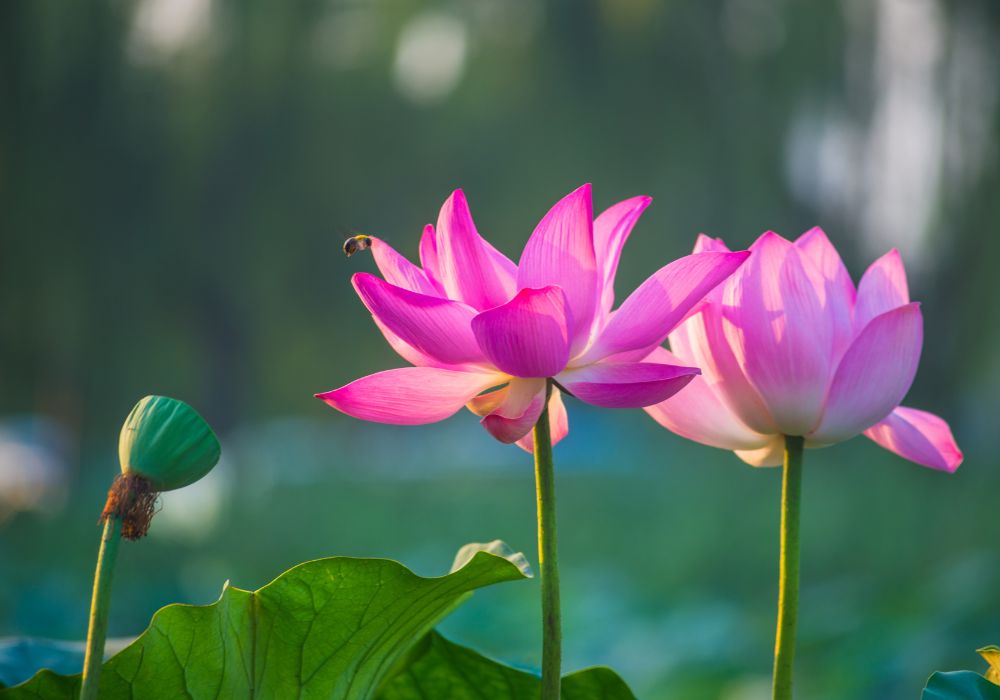
Caring for Lotus Flowers
Good care is crucial once planted to ensure that lotus flowers flourish and bloom brilliantly. Although they are rather low-maintenance, caring for these gorgeous aquatic plants requires several careful considerations. Here, we will discuss how to give your lotus flowers the correct water conditions, nutrients, and protection to maintain their health throughout the growing season.
Watering and Water Quality
Maintaining the right water conditions is among the most crucial aspects of tending lotus flowers. These plants need still or slow-moving water, so they must be placed in ponds or containers free from significant currents. Check the water level often to ensure it stays at the ideal depth, usually 12 to 18 inches. Water evaporates fast in hot weather, so you might have to add water to keep the proper level.
Similarly crucial is the water’s quality. Lotus blossoms prefer fresh, clean water; thus, try not to let the water stagnate or become contaminated. If you find trash, algae, or murkiness, think about routinely cleaning the area or using a pond filter. Container-grown plants especially depend on you looking for trash like dirt or leaves that might sink in the water. Maintaining clear water will help to prevent disease and encourage good growth.
Fertilizing for Healthy Growth
Because they are heavy feeders, they require a consistent supply of nutrients to develop and blossom to their best potential. Perfect for supplying the nutrients lotus flowers need, aquatic fertilizers, especially meant for water plants, Usually span spring to late summer; the active growing season calls for applying these fertilizers in either tablet or granular form.
Start fertilizing after the lotus plant generates several leaves. This guarantees that the plant has become established and ready to take in nutrients. Fertiliser tablets close to the roots of pond-grown lotus flowers or slow-release fertilizers that progressively supply nutrients over time will help. Take care not to overfertilize; this might cause algae blooms and compromise the water quality. Usually, one monthly application during the growing season will maintain your plants in good condition.
Managing Pests and Diseases
Although lotus flowers are hardy plants, occasionally, they fall victim to diseases and pests. Aphids, spider mites, and caterpillars are among the common pests that might compromise leaves and the plant’s general state. To control these pests, inspect your plants often for evidence of an infestation, such as holes in the leaves or obvious insects. Aphids, for instance, can be hand-removed or gently sprayed off with water.
Should pests continue, consider using safe natural or organic insecticides for aquatic plants. Using environmentally friendly solutions is best when tending to lotus flowers since chemical insecticides might damage the water ecosystem. Apart from pests, fungal infections can also compromise lotus blossoms, particularly in cases of poor water quality. Ensure the water is clear, and the plants get enough sunlight to stop fungal development. Eliminating dead or damaged leaves right away also helps stop disease from spreading.
Pruning and Deadheading
To encourage continuous blooming, regularly prune your lotus flowers. Deadheading, or removing spent flowers, allows the plant to focus on producing new blooms rather than expending resources on fading ones. You can simply snip off the dead flower heads with a pair of garden shears, cutting them just above the waterline.
In addition to removing spent flowers, it’s also important to remove yellowing or dead leaves. This not only improves the appearance of your water garden but also prevents the buildup of organic material in the water, which can lead to algae growth or attract pests. Regular pruning will help keep your lotus flowers looking their best and encourage more abundant blooms throughout the season.
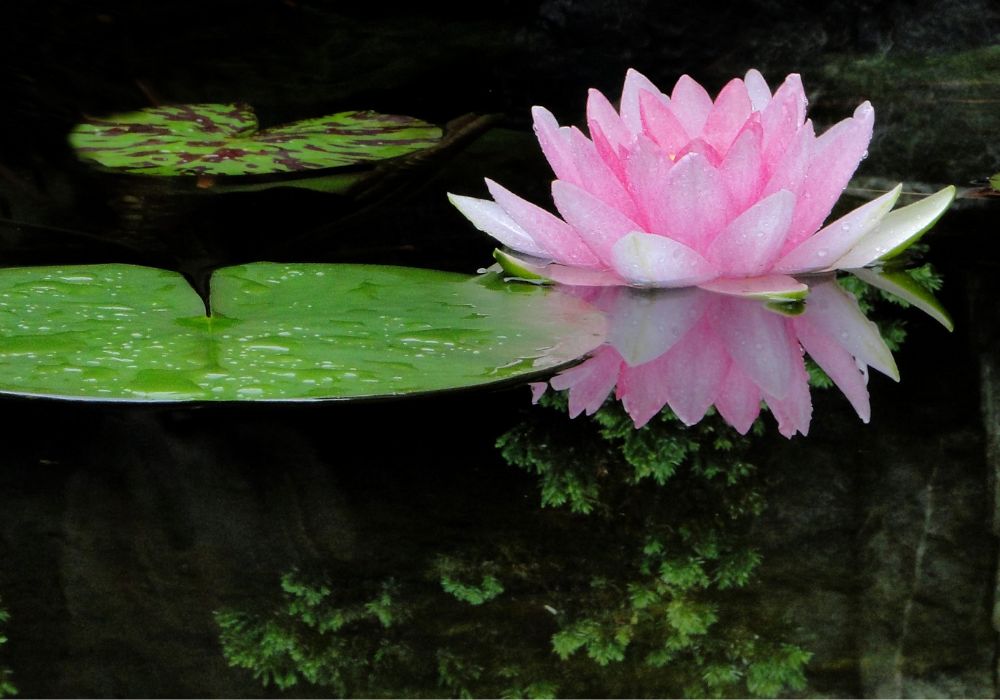
Seasonal Maintenance
tending lotus flowers calls for awareness of seasonal changes. Regular fertilizing, watering, and pruning are absolutely vital during the growing season. Your lotus plants will, however, start to go dormant as the temperature drops in late summer or early fall. Cut the fertilizer you apply now and let the plants naturally slow down.
In colder climates, you must be extra careful to guard your lotus blossoms through winter. Move the containers for pond-grown plants to a deeper section of the pond, where they will be sheltered from below-freezing conditions. If you are growing lotus flowers in a container, you might have to bring them indoors or keep the tubers cool and dark until spring. Cut back any dead or dying plants to prepare the others for dormancy before overwintering.
Ensuring Long-Term Health
If well taken care of, Lotus flowers can last for several years. The plants grow more set after the first season and call less attention. Still, you should monitor water quality, supply nutrients as needed, and guard the plants against diseases and pests. Beautiful blooms year after year from a well-kept lotus plant will provide your water garden elegance and peace.
Following these basic care tips will help you enjoy brilliant and healthy lotus blossoms throughout the growing season. Creating the correct surroundings, controlling pests, and preserving good water quality are key to ensuring that your lotus plants flourish and remain the focal point of your serene garden.
Conclusion
With enough care and attention, growing lotus flowers adds beauty and tranquilly to any water garden. Vibrant blossoms result from ensuring the correct surroundings, water quality, and nutrients. Your lotus plants will flourish and offer years of quiet enjoyment with little care.
We have more flower gardening guides available. Check out our narcissus flower article!




